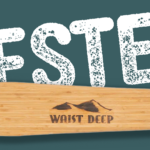The way some in marketing think these days, anyone over 25 isn’t worth spending ad dollars on unless the account is Gold Bond powder, walk-in bathtubs or an Anne Murray remix CD. Personally, my pants aren’t baggy enough to use as an emergency shelter but on the other hand, I also don’t set the waistband up to my armpits like a few uncool (non-skier) 40-somethings I know.
I buy stuff. And I buy stuff for my kids.
People selling stuff also need to realize that the bulk of skiers (60 per cent, according to the Canadian Ski Council, which collects numbers like this while the rest of us are out skiing) are between 25 and 49 winters old, but more importantly, a) the majority of them think, act, play and buy like they’re in their 20s; and b) they have far more money and far less debt than those under-25 guys in baggy pants and girls with pierced belly buttons— who, coincidentally, only make up 23 per cent of skiers in Canada.
A typical lift line varies, of course, region to region, day of the week, time of day, earlyseason vs. mid-season, visitors or locals…but the fact remains, around the world skiers (and snowboarders, for that matter) are getting older than even we like to think.
And then there’s the 50- to 64-year-old crowd on skis. One with, say, a neck tattoo might reason the over-50 lot looks for a resort with “a green run off every lift.” Wrong. This group has more experience than any; they’re hardly beginners. Savvy marketing types in the B.C. Interior know this already and are busy selling them upscale heli and snowcat weeks in paradise. They know who their market is and it’s not the baggy-pants crowd.
This jet set is indeed influential, but not recognized in the marketing world. You may have noticed that it’s not only boomers who love groomers, but their sheer numbers have persuaded most ski areas to concentrate more on preparing slopes. Some resorts even delay opening groomed runs because corduroy is often preferred, even after a big middle of- the-night dump. There was a time when expert terrain wasn’t groomed at all, but it’s hard to imagine major ski areas today without winchcats grooming black-diamond terrain. As hairlines recede and helmet-hair thins, so have gladed areas become more spacious.
It’s not the thousands of terrain park rats across the country who are driving the ski industry, they just help set trends among their own group. Meanwhile the hundreds of thousands of skiers who buy exponentially more stuff (including real estate) and actually go on ski trips make up the bread and butter. As exciting as the terrain park is, because of the relative participation it remains a niche along with backcountry skiing or telemarking.
It’s a bit like all the categories of skis in racks at shops across the country. Race pedigree at one time dictated what we all skied on. When I was a kid at the end of the baby boom, I had posters of Ingemar Stenmark, Franz “The Kaiser” Klammer and the Crazy Canucks on my bedroom walls. And I knew what they all skied on. There were few magazine and ski-DVD pro-skiers sharing the limelight. Snowboarding wasn’t carving out a quarter of the pie. And video games didn’t eat into what was left.
I was riding up on a quad the other day with three buddies and while looking down I noticed what was attached to our feet: fat twintips, über-carvers, teles and a board. How individual. But it doesn’t matter. The long-running greying trend in our sport controls more than half the market and they prefer all-mountain skis—whether or not they’re sexy in the eyes of the marketing boardrooms.



